How Close Is Genetic Makeup Between Siblings
Why siblings can accept the same ancestors, but different ethnicity estimates
Siblings practise have the same DNA but only share nigh 50 percentage (ii,600 centimorgans) with each other on average. Recombination is random so the corporeality of shared Dna ranges between 1,613-3,488 centimorgans. Identical twins have the aforementioned Deoxyribonucleic acid and share 100 percentage of the aforementioned Dna with each other 1 .
Genealogical Deoxyribonucleic acid tests frequently provide a profile that shows a person's ethnic groundwork. Many users are surprised to larn that their results can be slightly dissimilar from that of their siblings. While this might seem foreign or even impossible, it'south actually pretty mutual. It'due south a upshot of the complex relationship between genetics, ancestry, and ethnicity. How can siblings have different ethnicities when they accept the same parents?
This article will dive into the science of how Dna is passed down from parents to children. But start, allow's consider a real-world scenario that illustrates how ii siblings tin can stop up with dissimilar ethnicity estimates from their DNA test results.
Example: DNA Inheritance
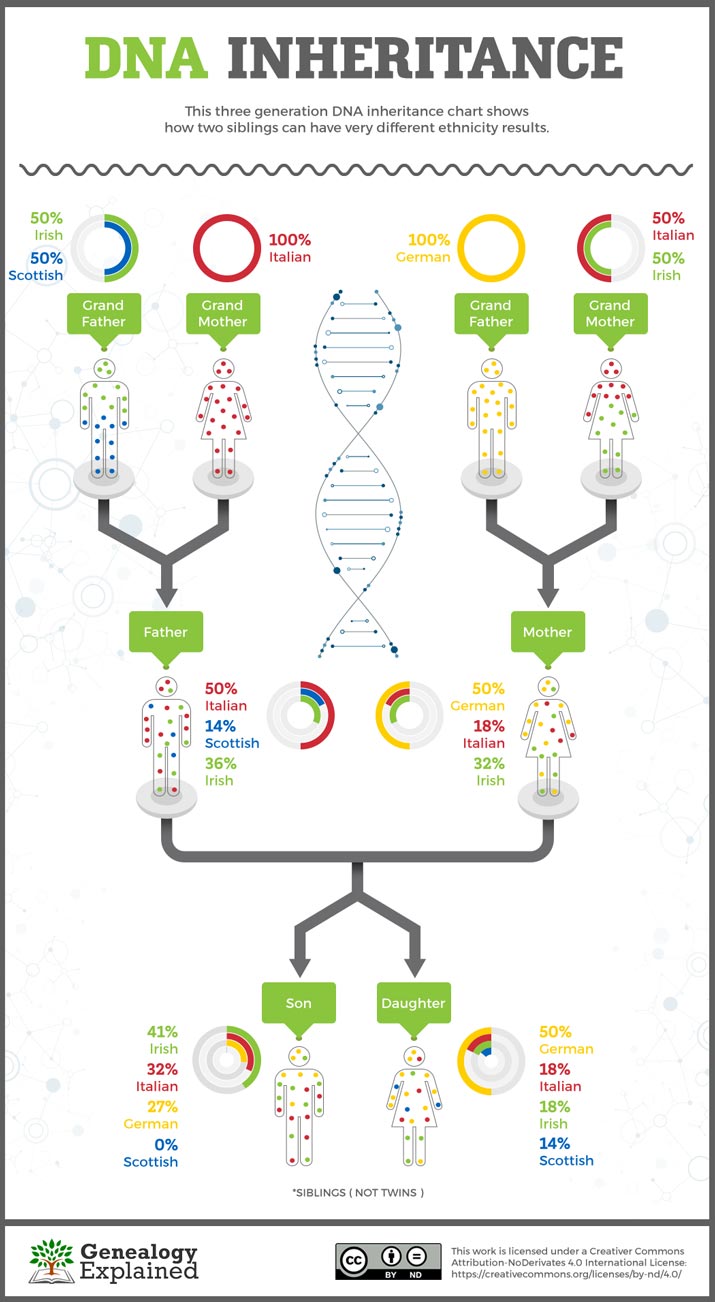
The issue of this simple three-generation Dna inheritance instance is that the 2 siblings have very different ethnic backgrounds – co-ordinate to their DNA. But by looking at the genetic profiles for each family member, we can see how the genes were passed downwardly over two generations and where they likely came from.
Ethnicity Estimates
It might seem natural to assume that the chromosomes each child receives are representative of their parents' chromosomes. For case, most people remember that if one of their parents is 100% Irish, that they must exist at least fifty% Irish gaelic.
In the example illustrated above, the mother is only 50% German, so the girl (also 50% German) might assume that her father is part German, too. Similarly, she might also suspect that her mother is part Scottish since both she and her father are 14% Scottish. But considering the ethnicities of the dissimilar family members, at that place are more probable scenarios that explicate how the genes were passed downwardly.
The daughter'due south DNA is 50% High german, simply the son is only 27%. Likewise, the daughter is 14% Scottish, just similar their father, but the son has no Scottish Deoxyribonucleic acid. I possible explanation is that the different Scottish genes crossed over onto one chromosome that the daughter received, but the son didn't. It's also possible that the son happened to get more genes from his Italian grandmother, instead. The son has more Irish genes as well. Taken together, this suggests that the son received more than DNA from their grandmothers and the girl received more from their grandfathers.
DNA Matches
There's another interesting outcome, too. Many genealogical Dna tests compare samples of their users to find possible relatives – a gold mine for genealogical research and breaking down brick walls. In this scenario, the daughter will take shared segments of Dna with Scottish relatives who won't friction match with her brother. Her blood brother might and then incorrectly presume that he'southward not actually related to those Scottish cousins. Even though they accept the aforementioned ancestors in common, they only don't share those specific segments of Dna. Note that this commonly will not happen with close cousins (beginning-third) due to the corporeality of total shared Deoxyribonucleic acid.
And so while an ethnicity written report can tell where an individual's genes originated, the results between close family members (such as siblings) will non always be the same. It'southward simply the unpredictable nature of genetic inheritance which is what makes every person unique.
Playing Cards
Let's talk about another illustration to drive abode this signal by using a deck of playing cards. The value of each carte represents a chromosome and each adjust represents the SNPs (single-nucleotide polymorphisms) of a item indigenous grouping (e.yard., Irish, Italian, German language, Scottish). Organize the cards by number and randomly bargain a hand with ane card of each number. Then, reshuffle the cards and repeat this a few times. Here are my results after dealing four hands:
Paw 1
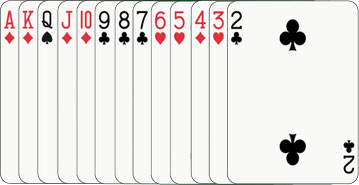
Hand 2
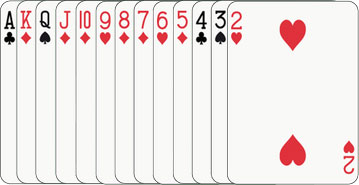
Hand 3
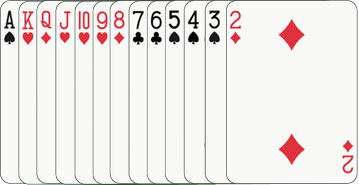
Hand iv
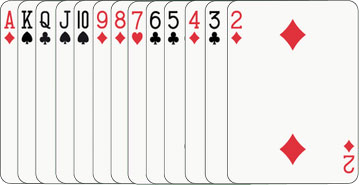
As yous can see, each hand is completely different, even though they were all drawn from the same deck. They also differ in how similar they are to each other. (For example, Paw ane has 5 cards in common with Hand 2, simply just 1 similar carte with Hand 3.) Now, let'south look at each hand and calculate the percentage of cards in each suit:
Hand i: ♠: 7.7% ♥: 23.1% ♣: 30.7% ♦: 38.five%
Hand 2: ♠: 15.4% ♥: 23.i% ♣: 15.4% ♦: 46.2%
Paw 3: ♠: 30.7% ♥: 30.7% ♣: xv.4% ♦: 23.1%
Hand iv: ♠: 23.one% ♥: 7.7% ♣: thirty.seven% ♦: 38.5%
Each hand has a completely different suit profile, likewise. None of the hands ended upwardly with the same percentages as the original deck (25% of each conform). Similarly, the genomes of two siblings are drawn from the same genetic deck, only they will likely depict different cards. This means the amount of Deoxyribonucleic acid they take in mutual will also vary.
On average, siblings normally share roughly 50% of their DNA with each other, only it depends on how their chromosomes randomly assorted.
How ethnicity is adamant from DNA
Let's now clarify how genealogical DNA tests are able to quantify someone's genetic ancestry. In other words, what exactly does it mean to say someone has "Irish gaelic" or "Nigerian" or "East Asian" genes? While every person's Dna is unique (except identical twins), the vast majority of the homo genome (over 99%) is identical in everyone. As humans have evolved, random mutations have accumulated in our Deoxyribonucleic acid, causing more variation between our genomes.
SNPs
The nearly common mutations are called single-nucleotide polymorphisms or SNPs (pronounced "snips"). This means that one base of Deoxyribonucleic acid has been changed at a detail location in the genome. For instance, a sequence of Dna that usually reads "…AAGTCACGTA…" might get changed to "…AAGTGACGTA…" instead.
If those mutations happen in sperm or egg cells, the altered sequence tin can get passed to a person's children, grandchildren, and future generations. Geneticists have classified millions of distinct SNPs in various locations in the genome.
When a group of people becomes isolated (geographically or culturally), new types of SNPs volition appear in the population. Over time, these variations volition become mutual within that group but rarely institute in others. (The human genome is over 3 billion bases long. SNPs occur randomly in the genome, so it is unlikely that the same mutation will occur twice in the aforementioned spot.) Past analyzing the genomes of many people in dissimilar groups, researchers tin identify the feature SNPs of that group.
DNA Testing
Genealogical Deoxyribonucleic acid tests clarify the SNPs in a person's genome and compare it to the genetic sample profiles associated with unlike ethnic groups. Using this information, they can determine someone'due south ethnic groundwork and where their ancestors are from. Each testing visitor uses their ain proprietary algorithms to summate this, so that'due south why your ethnicity results from AncestryDNA may wait dissimilar from your 23andMe results.
Inheritance and Genetic Variation
This all stems from how the genome is organized, divided, and recombined to brand a unique genome. The human genome is divided upward into long segments called chromosomes. There are 23 different pairs of chromosomes: Each genome has 22 pairs of autosomes (numbered ane-22) and either two 'X' chromosomes (in females), or one 'X' and ane 'Y' chromosome (in males) which is the 23rd chromosome. Under normal circumstances, everyone has two copies of each chromosome – one copy comes from their mother and one from their begetter. Egg and sperm cells (besides known as gametes) are formed in a process chosen meiosis.
Meiosis
Meiosis begins when the entire genome is duplicated in specialized precursor cells (called oocytes and spermatocytes), and Dna is condensed into chromosomes. Homologous chromosomes (different copies of the same chromosome) get paired together and neatly organized into a line inside the jail cell. When the prison cell starts to carve up, the chromosome pairs are pulled apart and evenly carve up between the new cells. These 2 cells then divide again, resulting in four cells, each with one copy of each chromosome. When the chromosomes are divvied up, they are sorted randomly into a prison cell. Each cell gets a copy of each chromosome from either the mother or the father, which volition eventually be passed on to their children.
Considering at that place are 23 chromosomes, there are over 8 million (2^23) possible combinations. This ways the genetic markers will be dissimilar in the cells passed down to different children. Consider this example:

This cell has been simplified to bear witness 3 types of chromosomes instead of the 23 found in the human being genome. As we tin can encounter, this person has ii copies of each chromosome. Their genetic ancestry is 50% Scottish (Blue) and 50% High german (Red). During the first step, the DNA duplicates and divides in two:

The chromosomes and then line up and divide again:

After the 2nd round of prison cell division, there are four gametes are produced, and each has ane copy of each chromosome. But notice what's happened to the beginnings! One-half of the gametes have 33% Scottish, 66% German language genes and the other half get 66% Scottish genes and 33% German.
If the child gets the gamete on the left, the Scottish ancestor volition contribute twice every bit much DNA to the genome than the 1 on the right. Even though the person had 50% Scottish and fifty% German genes, they passed on a different ethnic profile than their own. That's because the chromosomes arranged themselves into cells independently of each other. Because there are actually 23 chromosomes, it is unlikely to be that heavily skewed, but the two ancestors volition non contribute the exact aforementioned amount to each gamete.
Chromosomal Crossover
There's another important source of variation that occurs because of a process called chromosomal crossover. At the beginning of meiosis, after the genes were duplicated and lined up, the homologous chromosomes are briefly attached to each other. When chromosomes are bound together like this, they can swap sections of DNA:

The amount of crossing over that occurs is random, but It's thought to occur in every gamete. Sometimes it'due south pocket-size pieces of DNA, other times its large fractions of the chromosome. Because the maternal and paternal chromosomes tin can now exchange genes, countless new combinations are possible. Let's run across what happens subsequently meiosis continues the way it did before:

After crossing over, the gametes have even more varying genetic ethnicities equally before. That's how families can wind up passing on ethnic profiles in unexpected ways.
FAQ
Siblings share around 50% of their Dna with each other. This seems like a lot but permit us remember about it in these terms – siblings also have 50% of their Dna that they do not share with their siblings! This is mostly about 2210-3384 cM (centiMorgans – unit of measurement which measures amounts of shared Dna).
Fraternal twins share the aforementioned womb just they too will only share the same 50% as non-twin siblings would. Identical twins, coming from the same egg, would share nearly of their genetic makeup with one another though mutations are known to have taken place which can cause differentiation to their results every bit well. Semi-identical twins, on average, would share nigh 75% of their genetic make-upwardly.
Not likely. Half siblings by and large share between 1,200 – 2,300 cMs but those who share between ii,000 cM to 2,3000 cM are quite iffy. This is when information technology is important to look at the shared matches. If you and your sibling share within this iffy range but share about of the aforementioned matches, y'all are likely total siblings. If there are huge discrepancies in the Deoxyribonucleic acid matches, information technology is likely a half-sibling human relationship.
Practise siblings accept the same ethnicity?
Nope. You might have more Irish where your blood brother or sister might have an extensive amount of Swedish that you don't have at all. This does non mean you're not full siblings, it just displays the process of recombination which occurs between every parent and every child. Your sibling may inherit a larger segment from an Irish ancestor and yous may inherit a larger segment from a Swedish ancestor. Due to the fact that Deoxyribonucleic acid is all random, these estimates generally differ from sibling to sibling.
Practise siblings have the same chromosomes?
Not at all. During recombination, when the genetic material is passed down from parent to kid, the children and it's siblings would retain about 50% of the aforementioned DNA. This ways that the children would share replicas of pieces of their parent segments on the exact chromosomes. Heed you, it does not mean the segment volition be the exact same size. The recombination process can snip segments and so your sibling might have a large segment on their paternal 2d chromosomes that you only take a tiny piece of. Again, this is all normal.
Can 2 brothers take the same DNA?
Two brothers likely practice accept 50% of their DNA in common. However, that means it is also l% different. Agreement this can be complicated. The only way siblings can share the vast majority of their genetic makeup is if they are identical twins (coming from the aforementioned egg and aforementioned sperm).
Can a Deoxyribonucleic acid exam testify siblings?
Of course. Deoxyribonucleic acid testing can prove whatever kind of human relationship. Even those that are generally more difficult to sus out due to pedigree plummet and endogamy. DNA testing has proved very useful in identifying full siblings and half-siblings for adoptees. Though this technology tin bring incredible people into our lives and answer a lot of life's questions, information technology tin can besides bring some tough realities. For instance, hundreds of thousands of people have received DNA kits as gifts and, upon the opening of their results, they larn that their mother was not their mother, or their father was not their father. These events occur every day! These results are most commonly discovered when your full sibling pops up as a half-sibling.
Tin Dna tell if siblings have the same father?
Dna tin can definitely be the tell-all when information technology comes to you lot sharing a different father. When yous receive your results, you have to larn how to read them correctly to determine whether or not yous and your siblings are full siblings. You can do this by locating the amount of shared cM's that you share with your sibling in question and from there, you tin can decide if you lot have all of the same matches. Yous volition have maternal matches and paternal matches and so knowing which of the matches pertain to each parent, you would exist able to determine whether you and your sibling both share paternal cousins or not.
Information technology is important to understand these processes every bit nosotros begin our genetic research in order to keep our heads on straight. Agreement recombination and how information technology affects siblings' results is very important and will keep you from questioning your own parentage.
Conclusion
I hope this article was helpful for understanding how and why siblings might accept completely dissimilar genetic ethnicities even though they share the same ancestors and cultural backgrounds. For more information on DNA testing and how to choose a test for your genealogy goals, check out my guide to the all-time DNA examination.
Sources:
The 1000 Genomes Project Consortium. An integrated map of genetic variation from i,092 human genomes. Nature 491 (7422), 56-65. Nov. 1, 2012.
<https://world wide web.ncbi.nlm.nih.gov/pmc/articles/PMC3498066/>
Vignal A, Milan D, SanCristobal M, Eggen A. A review on SNP and other types of molecular markers and their use in animal genetics. Genetics Pick Evolution 34 (275). Feb eleven, 2002.
<https://gsejournal.biomedcentral.com/articles/x.1186/1297-9686-34-3-275>
Jones GH, Franklin FCH. Meiotic Crossing-over: Obligation and Interference. Cell 126. July 28, 2006. 246-248.
<https://world wide web.prison cell.com/jail cell/abstruse/S0092-8674(06)00903-2>
Griffiths AJF, Wessler SR, Lewontin RC, Gelbart WM, Suzuki DT, Miller JH. An Introduction to Genetic Assay, Eighth Edition. New York: Due west.H. Freeman and Visitor, 2005. 96-103.
<https://books.google.com/books?id=qtboPf9eeUkC&lpg=PR13&ots=Rl4_QRpIWa&dq=mendelian genetics chromosomes&lr&pg=PA96 – v=onepage&q=mendelian genetics chromosomes&f=false>
Footnotes
- https://thegeneticgenealogist.com/2017/08/26/august-2017-update-to-the-shared-cm-project/
Source: https://www.genealogyexplained.com/dna-testing/do-siblings-have-same-dna/
Posted by: schmidtlonst2001.blogspot.com

0 Response to "How Close Is Genetic Makeup Between Siblings"
Post a Comment